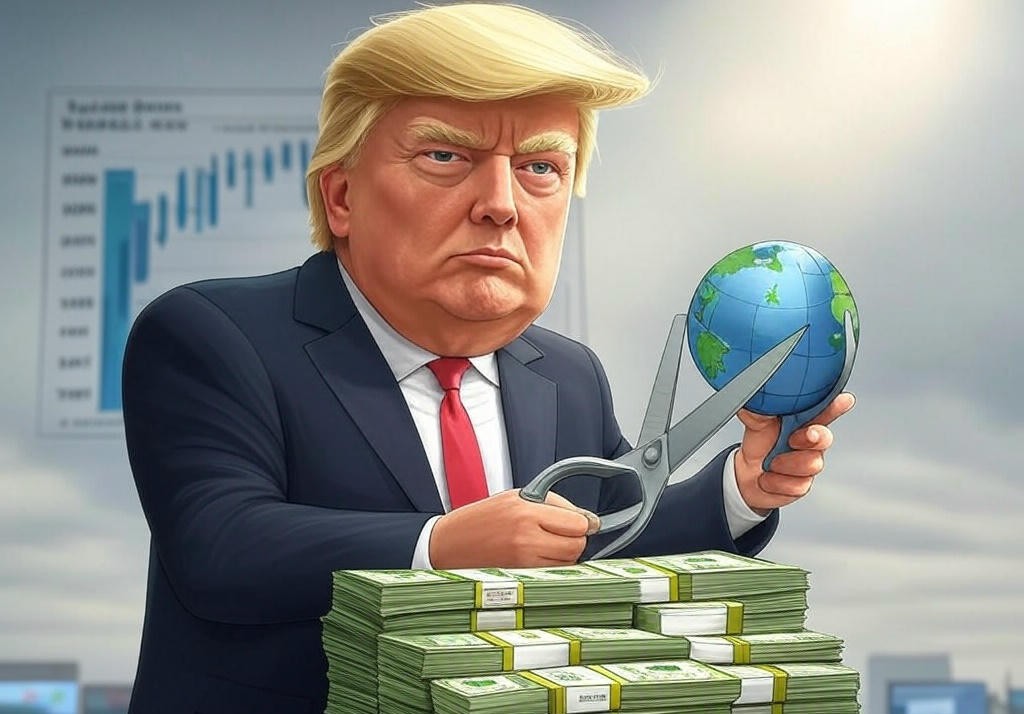The U.S. economy is going through big changes in 2025 with President Donald Trump’s new U.S. budget plan global funding decisions, job market shifts and trade policies creating both opportunities and challenges.

Trump’s $163 Billion Budget Cut
President Trump’s administration recently proposed a $163 billion cut to the federal budget for 2026. This plan focuses on reducing spending on domestic programs like education housing and medical research. Instead the budget increases funding for defense and border security. According to the White House Office of Management and Budget (OMB) non defense discretionary spending (which does not include big programs like Social Security or Medicare) will drop by 23% the lowest since 2017. The goal is to shrink what some call a “bloated” government and focus on national security.
For example the budget cuts about 15% from the Department of Education and nearly half from the Department of Housing and Urban Development. It also reduces funding for NASA’s moon program and federal law enforcement agencies like the FBI. On the flip side defense spending will rise by 13% and homeland security spending will jump by 65%. This includes $500 million more for border security $766 million for border technology and funds to support 22000 Border Patrol agents.
Democrats like Senator Chuck Schumer argue these cuts hurt working families by slashing programs they rely on. Some Republicans also want more defense spending saying the current plan does not go far enough. With the U.S. national debt at $36 trillion opinions are split on whether these cuts will help or harm the economy.
World Bank’s $3.2 Billion Fund
While the U.S. is cutting domestic spending it’s also contributing to global efforts. The World Bank is getting $3.2 billion to help poorer nations create jobs and grow their economies. This fund aims to support countries struggling with poverty and unemployment helping them build stronger economies. It’s a way for the U.S. to stay involved in global development even as it focuses on domestic priorities. This move shows a balance between looking inward and supporting the world economy.
Job Growth Slows Down
The U.S. job market is feeling the heat from economic uncertainty especially due to Trump’s tariff policies. In April 2025 the U.S. added 177000 jobs which was more than the expected 133000 but less than March’s 185000. The unemployment rate stayed steady at 4.2%. Sectors like transportation and warehousing grew adding 29000 jobs as businesses stocked up on goods before new tariffs hit. However federal government jobs dropped by 9000 reflecting Trump’s push to reduce government staff through the Department of Government Efficiency led by Elon Musk.
Despite these job gains experts see signs of a slowing economy. Consumer spending a big driver of growth fell by 0.5% in January especially for big items like cars. This could mean people are worried about the future and holding onto their money. The Economic Policy Uncertainty Index which measures how unsure businesses and consumers feel hit its highest level since December 2020.
Tariff Troubles and Economic Uncertainty
Trump’s tariffs are shaking things up. He’s imposed high taxes on imports like 25% on goods from Canada and Mexico 10% on most other imports and up to 145% on Chinese products (though smartphones and computers are exempt). These tariffs aim to protect American businesses but are causing problems. Other countries like China are hitting back with their own tariffs making it harder for U.S. companies to sell abroad.
The International Monetary Fund (IMF) says these tariffs will slow the U.S. economy predicting growth of just 1.8% in 2025 down from 2.7% in 2024. Globally economic growth will drop to 2.8%, and there’s a 40% chance of a U.S. recession. Businesses are hesitant to invest and consumers are spending less partly because tariffs could raise prices. For example imported goods like cars or electronics might cost more squeezing family budgets.
Federal Reserve Holds Steady
The Federal Reserve which sets interest rates is expected to keep rates unchanged for now. With inflation at 2.5% in February 2025 the Fed is watching the economy closely. Trump has pushed for lower rates to boost growth but experts like Olu Sonola from Fitch Ratings say the Fed won’t act until the job market shows clear weakness. High interest rates make borrowing more expensive which can slow spending and growth but help control inflation.
What Does This Mean for You?
These changes affect everyday Americans in different ways. Budget cuts might mean less funding for schools or housing programs but more focus on security could create jobs in defense. Tariffs might raise prices for things like clothes or gadgets but they could also bring some manufacturing jobs back to the U.S. Slower job growth and economic uncertainty might make it harder to find work or get a raise but the Fed’s steady rates aim to keep inflation in check.
Looking Ahead
The U.S. economy is at a crossroads. Trump’s budget and tariff policies are bold moves to reshape how the country spends and trades. The World Bank fund shows the U.S. still plays a global role but at home the focus is on cutting back and protecting American interests. With job growth slowing and a possible recession looming 2025 will be a year to watch. Americans will need to stay informed and adapt to these changes whether it’s budgeting for higher prices or navigating a shifting job market.
